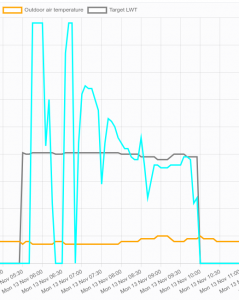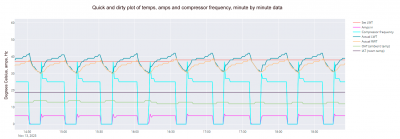Grant Aerona Setback
Posted by: @derek-mIn the right hand chart did you vary the Target LWT or was this done by the controller?
It's being varied by the controller's WC - see below where I've just shown the 'Target LWT' vs OAT (and compressor freq) for that same time period; the Target LWT just reflects the OAT. On the Grant, as you know, the WC curve is just a straight line.
For clarity, all values are coming directly from the Grant HP, apart from 'Target LWT' which I calculate based on the OAT and WC curve (line) as defined by the 4 control parameters. I'm confident the calculation is correct given the observed modulation of compressor frequency when LWT reaches the Target LWT. My long-term plan is to modulate the LWT based on IAT as well, but that's down the line - I have flow rates and zoning to work on first.
Grant Aerona 3 10kW
Posted by: @cathoderay@mikefl - a useful comparison, even if it is, I agree, a rather busy chart! There is a more marked spike, but there is also a notable dip after the spike, meaning we may want to consider the area under the curve, rather than moment by moment values. And, although it is a bigger spike, it isn't huge, eg the added area under the curve in the left hand chart caused by the spike isn't that large compared to the total area under the curve.
I was vaguely under the impression that modern compressors have a slow start up, ie they wind up slowly, rather than jamming straight away into top gear, precisely to limit start up current draw (and perhaps other things as well). That's why I think the 'start ups carry a heavy current penalty' thing may be a hang over from the older heat pumps, that no longer applies to newer ones.
I think that you will find that the 'soft' start for an electric induction motor is only over a period of seconds, to limit the current inrush.
The compressor will probably start unloaded, so running at full speed will only draw slightly higher current. The loading increases as the pressure within the system builds, making the compressor work harder.
Posted by: @mikeflMy long-term plan is to modulate the LWT based on IAT as well, but that's down the line
I'm already doing that, and most of the time it works, but I still have to iron out a bug, running my hourly auto-adaption script, which varies the LWT depending on the difference between the actual and desired IAT, terminates the DHW heating if it happens to be on when the script runs. I've just adjusted the code so that it will only run if the DHW is off, generally not a limit as the DHW, which is on a timer, usually only comes on between 1300 and 1400 daily.
Posted by: @derek-mI think that you will find that the 'soft' start for an electric induction motor is only over a period of seconds, to limit the current inrush.
The compressor will probably start unloaded, so running at full speed will only draw slightly higher current. The loading increases as the pressure within the system builds, making the compressor work harder.
I don't currently collect compressor frequency, but it appears to be available over modbus. I will add it, and we should then be able to see how amps and compressor frequency are related. That said, are we right to assume compressor frequency is a direct measure of how hard it is working?
Midea 14kW (for now...) ASHP heating both building and DHW
No and yes, compressor frequency denotes how fast the compressor is running. How hard it is working is dependent upon the pressure within the condenser.
Think of pumping up a bicycle tyre using a hand pump. When the pressure is low it is quite easy to operate the pump, but as the pressure builds, so does the amount of effort required to move the pump.
I have noticed with our A2A heat pump, when it first starts the compressor run quite fast, but the quantity of electrical energy being consumed is not too high. As the heat pump gets to the point of supplying thermal energy, the compressor slows, but the amps increase.
Obviously as the amount of thermal energy being produced increases, the compressor speed also needs to increase, since it is moving more refrigerant gas around the system.
It will be interesting to see how the compressor speed varies with thermal energy output.
Posted by: @derek-mIt will be interesting to see how the compressor speed varies with thermal energy output.
Here we go, data from the last few hours since I added compressor frequency to the data, as it happens a period of relative stability in OAT, though it has been breezy (wind chill and, in my case drafts):
I suppose it is pretty much as expected, high compressor frequency at start up, slows as it comes under load, with the small uptick in amps at startup? I haven't included the energy in/out bar chart because that is hourly data, minute by minute variations will be lost. In the above chart, given the flow rate remains constant, as does the specific heat of the fluid, the LWT/RWT delta t can act as a proxy for the thermal energy output.
Midea 14kW (for now...) ASHP heating both building and DHW
-
Thermostat for Ideal Logic Air with 3 zone support
5 months ago
-
Grant Aerona Setback
2 years ago
- 26 Forums
- 2,426 Topics
- 55.1 K Posts
- 329 Online
- 6,104 Members
Join Us!
Worth Watching
Latest Posts
-
RE: Is my Samsung gen6 outside air temp sensor missing a sheath/sleeve?
@toodles Don’t get me started on car headlight bulbs!
By Papahuhu , 8 minutes ago
-

RE: The good, the bad and the not that great – my heat pump installation
@burtis I only use the app to see what is going on and ...
By Toodles , 26 minutes ago
-
RE: Installer Fitted 9kW Instead of 11kW Heat Pump and Changed MCS Paperwork - What do I do?
I've now had an interesting email from a Complaints Res...
By MairiA , 32 minutes ago
-
RE: R290 and Foundation Air Bricks
I discussed this topic with my installer late last year...
By EffTee , 38 minutes ago
-

RE: Reliable, easy to use home battery options
Correct. LiFePO₄ cells mustn't be charged if their te...
By Transparent , 41 minutes ago
-

RE: Water outage in the the south-east
Indeed!Any contamination in the well water would be tra...
By Transparent , 3 hours ago
-
RE: Solis inverters S6-EH1P: pros and cons and battery options
I hear some cases of apparent misconfiguration of inver...
By Batpred , 3 hours ago
-
Are split ASHPs with R290 refrigerant coming soon?
Question. Are there any (or likely to be in the near t...
By iotum , 5 hours ago
-

RE: Setback savings - fact or fiction?
Indeed. In many ways, a defrost is a setback, with the ...
By cathodeRay , 5 hours ago
-
RE: Heat pump not reaching flow temperature
The good news is that it leaves no excuse if it doesn't...
By JamesPa , 6 hours ago
-
RE: How to use my Hanchu battery storage for home without it feeding back into the grid?
@countryman-helmsley In that case is there a button ...
By IRMartini , 6 hours ago
-
RE: Recommended home battery inverters + regulatory matters - help requested
Thanks. Thats pretty much my intended route i...
By JamesPa , 7 hours ago
-
RE: Is it normal to use power from the grid when running off the battery?
The Solis S6 has various modes of use. I currently have...
By Batpred , 7 hours ago
-
RE: Ideal HP290 14kW ASHP - how to optimise
Great. It’s not bad is it, though I agree it may repres...
By Davesoa , 7 hours ago
-
RE: Ecodan Pump Issues… Circulation pump turns off when heat pump compressor turns off
@f1p apologies, you are absolutely correct
By Patch321 , 8 hours ago
-

RE: Samsung E101 Error Message and my ASHP Efficiency
@johnnyb amazing that the our forum is serving its purp...
By Mars , 22 hours ago
-
Best option for controller upgrade? - Grant Aerona
Fairly new heat pump owner - Grant Aerona 3 10kw - and ...
By Topher , 22 hours ago
-
RE: Daikin Wireless Thermostat
@toodles Yes. British Gas seems to have done an exce...
By Bash , 1 day ago
-

Just a brief update to keep things transparent. Secti...
By DREI , 1 day ago
-

I continue to receive emails from homeowners sharing he...
By Mars , 1 day ago






